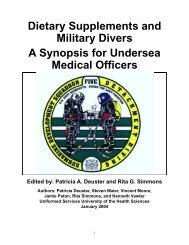Force Health Protection: Nutrition and Exercise Resource Manual
Force Health Protection: Nutrition and Exercise Resource Manual
Force Health Protection: Nutrition and Exercise Resource Manual
Create successful ePaper yourself
Turn your PDF publications into a flip-book with our unique Google optimized e-Paper software.
◆ If using resistance machines, adjust the pads to fit your body size.<br />
This is very important since the pads support you during the lift.<br />
Keep your head level <strong>and</strong> eyes focused straight ahead.<br />
◆ Lifts should be slow, smooth, <strong>and</strong> controlled. Lift the weight<br />
for at least 2 seconds <strong>and</strong> lower the weight for at least 4 seconds<br />
to ensure that your muscle, not momentum, moves the weight.<br />
◆ Exhale during the exertion (moving the weight against gravity),<br />
<strong>and</strong> inhale when returning to the start position. Holding your<br />
breath (Valsalva maneuver) causes extremely high increases in<br />
blood pressure <strong>and</strong> can damage the cardiovascular system. Never<br />
hold your breath while exercising!<br />
◆ Always use a spotter when lifting free weights.<br />
The most common training errors occur when people focus on lifting the<br />
weight rather than focusing on stabilizing themselves <strong>and</strong> controlling the<br />
weight. The best way to avoid training mistakes is to ask a staff member at<br />
the gym to teach you new exercises <strong>and</strong> to suggest the best exercises for you<br />
based on your fitness level <strong>and</strong> goals. See Appendix C for examples of<br />
common errors in training techniques.<br />
FITT Principle Guidelines<br />
Once you are comfortable with the basic training techniques for<br />
performing strength exercises, follow the FITT Principle, illustrated in the<br />
Physical Activity Pyramid (Chapter 4, Figure 4-2), to set up your routine.<br />
The FITT guidelines for strength training are:<br />
◆ Frequency - 2 to 3 times per week for each major muscle group on<br />
non-consecutive days.<br />
◆ Intensity - the total weight lifted or the resistance.<br />
◆ Time - the duration of the exercise.<br />
◆ Type - equipment used <strong>and</strong> the exercises performed.<br />
Two terms you need to know are repetition (rep) <strong>and</strong> set. A repetition<br />
is a single lifting <strong>and</strong> lowering of the weight. For example, one rep of a leg<br />
curl is equivalent to lifting your ankle toward your buttocks, pausing one<br />
second, then returning your ankle to the start position. A set is the number<br />
of reps performed without stopping to rest. For example, if you perform 10<br />
leg curls, rest for 60 seconds, followed by another 10 leg curls, you would<br />
have performed 2 sets, each of 10 leg curls. When recording the number of<br />
sets <strong>and</strong> reps performed, write “sets x reps” (e.g., 2x10 for the leg curl<br />
example above).<br />
<strong>Nutrition</strong> <strong>and</strong> <strong>Exercise</strong> <strong>Resource</strong> <strong>Manual</strong> 59




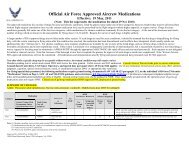

![Body Composition and Military [PDF] - Human Performance ...](https://img.yumpu.com/43269347/1/190x245/body-composition-and-military-pdf-human-performance-.jpg?quality=85)
![Tips for Grocery Shopping [PDF]](https://img.yumpu.com/37447379/1/190x245/tips-for-grocery-shopping-pdf.jpg?quality=85)
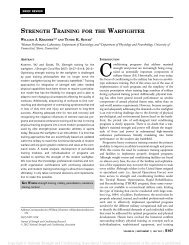
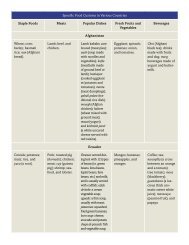
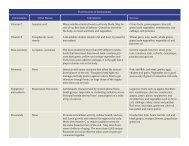
![Synthetic Drugs [PDF] - Human Performance Resource Center](https://img.yumpu.com/37447322/1/190x245/synthetic-drugs-pdf-human-performance-resource-center.jpg?quality=85)
